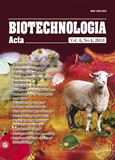ISSN 2410-7751 (Print)
ISSN 2410-776X (Online)

"Biotechnologia Acta" v. 6, no. 4, 2013
https://doi.org/10.15407/biotech6.04.182
Р. 182-189, Bibliography 15, Ukrainian
Universal Decimal classification: 577.218
1Palladian Institute of Biochemistry of National Academy of Sciences of Ukraine, Kyiv, Ukraine
2Faculty of Fundamental Medicine, Lomonosov Moscow State University, Moscow, Russia
3Department of Biochemistry and Biocenter Oulu, University of Oulu, Oulu, Finland
Ruk/CIN85 is an adaptor protein that plays important roles in the regulation of cellular processes such as cell death, proliferation and motility. It was recently shown that overexpression of Ruk/CIN85 increases the oncogenic potential of human breast adenocarcinoma MCF-7 cells. It was the aim of the present study to investigate whether inhibition of Ruk/CIN85 expression has an effect on the biological properties of the cells. In order to down-regulate Ruk/CIN85 expression of small interfering RNA-based approach was used. For down-regulation of Ruk/CIN85 lentiviral constructs encoding Ruk/CIN85-specific small hairpin RNA sequences were generated. By using the obtained recombinant lentiviruses it was shown that inhibition of Ruk/CIN85 expression influences biological properties (motility, proliferation, ABCG2 expression, and ROS generation) of various tumour cell types such as human breast adenocarcinoma MCF-7, human colorectal adenocarcinoma HT-29, and Lewis mouse lung carcinoma cells.
Key words: adapter proteins, Ruk/CIN85, RNAinterference, lentiviral vectors, cell motility, active oxygen forms.
© Palladin Institute of Biochemistry of National Academy of Sciences of Ukraine, 2013
References
1. Flynn D. C. Adaptor proteins. Oncogene. 2001, 20(44), 6270–6272.
https://doi.org/10.1038/sj.onc.1204769
2. Dikic I. CIN85/CMS family of adaptor molecules. FEBS Lett. 2002, 529(1),?110–115.
https://doi.org/10.1016/S0014-5793(02)03188-5
3. Gout I., Middleton G., Adu J. et al. Negative regulation of PI 3-kinase by Ruk, a novel adaptor protein. EMBO J. 2000, 19, (15), 4015–4025.
https://doi.org/10.1093/emboj/19.15.4015
4. Havrylov S., Redowicz M. J., Buchman V. L. Emerging roles of Ruk/CIN85 in vesicle-mediated transport, adhesion, migration and malignancy. Traffic. 2010, 11(6), 721–731.
https://doi.org/10.1111/j.1600-0854.2010.01061.x
5. Samoylenko A., Vynnytska-Myronovska B., Byts N. et al. Increased levels of the HER1 adaptor protein Rukl/CIN85 contribute to breast cancer malignancy. Carcinogenesis. 2012, 33(10), 1976–1984.
https://doi.org/10.1093/carcin/bgs228
6. Sliva K., Schnierle B. S. Selective gene silencing by viral delivery of short hairpin RNA. Virol. J. 2010, V. 7, P. 248.
https://doi.org/10.1186/1743-422X-7-248
7. Stewart S. A., Dykxhoorn D. M., Palliser D. Lentivirus-delivered stable gene silencing by RNAi in primary cells. RNA. 2003, 9(4), 493–501.
https://doi.org/10.1261/rna.2192803
8. Mo W., Zhang J. T. Human ABCG2: structure, function, and its role in multidrug resistance. Int. J. Biochem. Mol. Biol. 2012, 3(1), 1–27.
9. Mayevska O., Shuvayeva H., Igumentseva N. et al. Expression of adaptor protein Ruk/CIN85 isoforms in cell lines of various tissue origins and human melanoma. Exp. Oncol. 2006, 28(4), 275–281.
10. Mosmann T. Rapid colorimetric assay for cellular growth and survival: Application to proliferation and cytotoxicity assays. J. Immunol. Meth. 1983. 65(1–2). P. 55–63.
https://doi.org/10.1016/0022-1759(83)90303-4
11. Gianni D., Bohl B., Courtneidge S. A. The involvement of the tyrosine kinase c-Src in the regulation of reactive oxygen species generation mediated by NADPH oxidase-1. Mol. Biol. Cell. 2008, 19(7),?2984–2994.
https://doi.org/10.1091/mbc.E08-02-0138
12. Nam J. M., Onodera Y., Mazaki Y. et al. CIN85, a Cbl-interacting protein, is a component of AMAP1-mediated breast cancer invasion machinery. Embo J. 2007, 26(3), 647–656.
https://doi.org/10.1038/sj.emboj.7601534
13. Petry A., Weitnauer M, G?rlach A. Receptor activation of NADPH oxidases. Antioxid Redox Signal. 2010, 13(4), 467–487.
https://doi.org/10.1089/ars.2009.3026
14. Ferrell J. E. J. What do scaffold proteins really do? Sci. STKE. 2000, V. 52, P. e1.
15. Razidlo G.?L., Kortum R.?L., Haferbier J.?L., Lewis R.?E. Phosphorylation regulates KSR1 stability, ERK activation, and cell proliferation. J. Biol. Chem. 2004, 279(46), 47808–47814.
https://doi.org/10.1074/jbc.M406395200

